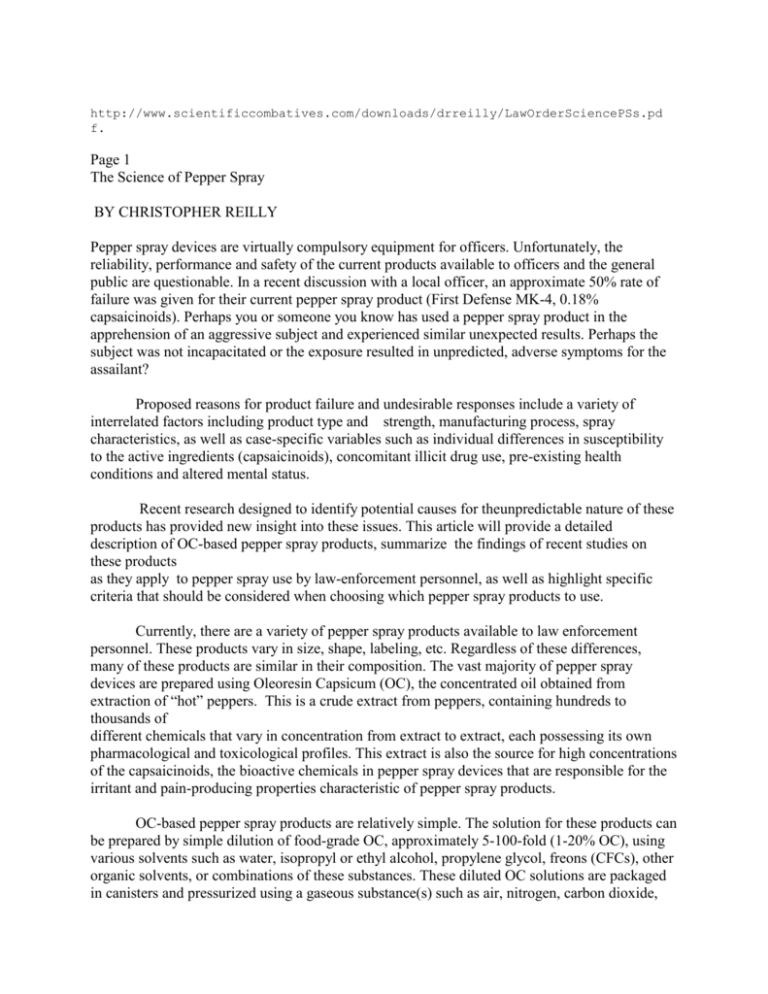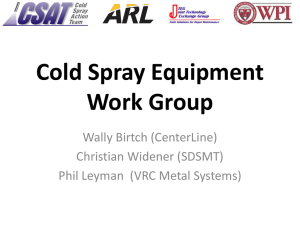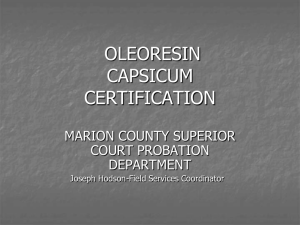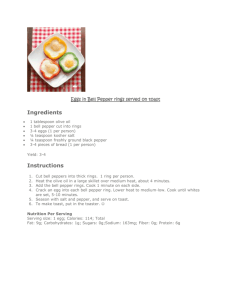hplc dioxide
advertisement

http://www.scientificcombatives.com/downloads/drreilly/LawOrderSciencePSs.pd f. Page 1 The Science of Pepper Spray BY CHRISTOPHER REILLY Pepper spray devices are virtually compulsory equipment for officers. Unfortunately, the reliability, performance and safety of the current products available to officers and the general public are questionable. In a recent discussion with a local officer, an approximate 50% rate of failure was given for their current pepper spray product (First Defense MK-4, 0.18% capsaicinoids). Perhaps you or someone you know has used a pepper spray product in the apprehension of an aggressive subject and experienced similar unexpected results. Perhaps the subject was not incapacitated or the exposure resulted in unpredicted, adverse symptoms for the assailant? Proposed reasons for product failure and undesirable responses include a variety of interrelated factors including product type and strength, manufacturing process, spray characteristics, as well as case-specific variables such as individual differences in susceptibility to the active ingredients (capsaicinoids), concomitant illicit drug use, pre-existing health conditions and altered mental status. Recent research designed to identify potential causes for theunpredictable nature of these products has provided new insight into these issues. This article will provide a detailed description of OC-based pepper spray products, summarize the findings of recent studies on these products as they apply to pepper spray use by law-enforcement personnel, as well as highlight specific criteria that should be considered when choosing which pepper spray products to use. Currently, there are a variety of pepper spray products available to law enforcement personnel. These products vary in size, shape, labeling, etc. Regardless of these differences, many of these products are similar in their composition. The vast majority of pepper spray devices are prepared using Oleoresin Capsicum (OC), the concentrated oil obtained from extraction of “hot” peppers. This is a crude extract from peppers, containing hundreds to thousands of different chemicals that vary in concentration from extract to extract, each possessing its own pharmacological and toxicological profiles. This extract is also the source for high concentrations of the capsaicinoids, the bioactive chemicals in pepper spray devices that are responsible for the irritant and pain-producing properties characteristic of pepper spray products. OC-based pepper spray products are relatively simple. The solution for these products can be prepared by simple dilution of food-grade OC, approximately 5-100-fold (1-20% OC), using various solvents such as water, isopropyl or ethyl alcohol, propylene glycol, freons (CFCs), other organic solvents, or combinations of these substances. These diluted OC solutions are packaged in canisters and pressurized using a gaseous substance(s) such as air, nitrogen, carbon dioxide, propane, isobutane, etc. Some manufacturers have employed a highly volatile solvent system to prepare their products, and, thus, the solvent also serves as the propellant by maintaining pressure in the canister by solvent evaporation to form a gas. Typical OC-based pepper spray devices can be effectively dispensed between 5-10 times using sequential one-second pulses from a range of 5-10 feet. Pepper spray weapons are designed to deliver concentrated solutions of capsaicinoids, a family of chemicals that produces the sensation of “hotness” or burning when “hot” peppers are ingested. Capsaicinoids, contained in OC, interact with a protein called the capsaicin receptor, a chemical sensor expressed by various human and animal cell types. Activation of this receptor on sensory nerve cells initiates a complex series of biochemical events that ultimately result in the perception of pain and coughing. The extent and severity of these responses are related to the amount of capsaicinoids delivered to the subject. When pepper sprays are used, the capsaicinoids present in the product activate the capsaicin receptor and cause the characteristic physiological effects described above. The overall intended effects are temporary and safe incapacitation of the subject and, hopefully, protection against aggressive attacks. There are many factors that can influence the performance and safety of pepper spray devices including the strength and characteristics of the capsaicinoid solution, as well as the efficiency and accuracy of delivery of the product. Individual differences in sensitivity to the capsaicinoids, tolerance, case-specific differences (drug use, goal orientation and altered mental status) and environmental conditions (space, ventilation and wind) can also influence the performance and safety of these products. In general, however, the most important determinant of product efficacy and safety is the amount of capsaicinoids delivered to the targeted subject. Recent research performed in our laboratories has demonstrated significant variability in the concentrations of capsaicinoids in OC-based pepper spray products. Analysis of multiple, randomly selected commercial pepper spray products used by law enforcement personnel and the general public (manufacturers included: First Defense, Defense Technologies, Guardian Personal Security Products, Inc., Security Plus, AERKO International, DMA, Mace Security International, Inc., Guardian Protective Devices, ChemArmor, Counter Assault Tactical Systems, UDAP Industries) has demonstrated that the concentration of capsaicinoids in these products varied up to 100-fold. In addition, this variability was independent of the brand name, manufacturer, labeled Scoville Heat Unit (SHU) rat ing, and %OC listed on the canister. In other words, not all 10% OC products that were rated at 2 million SHU were equal in strength. In fact, one manufactureros product that purportedly contained only five percent OC at 2 million SHU contained much higher concentrations of capsaicinoids than some of the 10% OC sprays also rated at 2 million SHU. Two manufacturerso 10% OC sprays were visibly much different in color and varied significantly in their concentrations of active ingredients, despite the canisters having identical labels! -----------------------------------------------------------------------Page 2 These studies demonstrated that the actual potency for many pepper spray products, as represented by labeled % OC and SHU value, was not representative of the true strength of the product. Such differences in the concentration of active ingredients may be a major contributing factor for the variability in performance and safety of these products. Would you be willing to risk your safety on a product that may or may not contain enough active ingredient to be helpful or high concentrations of toxic materials? Why are OC-based products so different? Differences in the strength for many OC-based products are likely the result of the manufacturing process and the source of the OC. Other than the obvious possibility that two products are just not prepared the same way, the materials used to prepare the products may also be different. OC-based pepper sprays are prepared using food-grade OC. The principal means for evaluating the strength of food-grade OC preparations, and subsequently pepper spray products, involves a taste test to subjectively assess the concentration of capsaicinoids. An SHU value is used to describe the strength or “hotness” of a product and is generated by determining the dilution required to ameliorate the pungency of a given OC preparation. Although a direct relationship between SHU value and capsaicinoid concentration has been demonstrated for OC, this relationship does not always remain. For example, when three OCs rated at 1 million SHU from different suppliers were assayed, small, but significant, differences in the capsaicinoid content were observed. Hence, the relationship between SHU and capsaicinoid concentration does not remain constant for most OC-based pepper spray products since different sources and lots of OC are frequently used to prepare the different products. Preparing pepper spray products by dilution of food-grade OC, without adequate analytical quality control testing (such as HPLC, GC/MS or LC/MS), can result in quantitatively different pepper spray formulations. These differences can ultimately impact the effectiveness and safety of the product. Additional factors that can affect the delivery of capsaicinoids are the solvent, propellant and nebulizer (spray nozzle) used to manufacture the product. For example, two identical products from the same manufacturer that were used in our studies exhibited only minute differences in their concentrations of capsaicinoids, but marked differences in their spray characteristics and solution viscosity, ranging from an oily product that was released as a cohesive stream to a highly aerosolized (fogger or gas) product that was prepared using ethanol as the solvent. Surprisingly, these differences were not described on the product labels, but may directly impact the use and performance of these weapons. Similarly, the solvent used to prepare the products can affect performance and safety through differences in the solubilization of the capsaicinoids, spray characteristics, differences in delivery and even differences in the potential toxicities of the solvent itself. Products prepared using nonvolatile, viscous or oily solvents typically require vigorous shaking before use and are dispensed as a cohesive and concentrated stream. As such, accuracy of the spray is essential for delivery of the capsaicinoids. Because of physical characteristics of the spray, the principal effects observed will likely be localized to the sites of exposure, namely ocular and dermal responses. Conversely, products formulated using volatile alcohols, halogenated and other volatile organic solvents will tend to nebulize more efficiently (sometimes called foggers or gas). These devices will require less accuracy for delivery, but should be used from closer ranges. Because of the efficient nebulization of these products, as well as the likelihood that delivery of capsaicinoids will be more widespread, the effects of exposure will likely involve more diverse responses including extensive respiratory effects. Some experts claim that the perception of pain alone is not enough to incapacitate or deter aggressive individuals or animals. Rather, inhalation of the spray to compromise respiratory function is required. One major disadvantage to the more highly nebulized products, however, is the increased propensity for inadvertent exposure to the user when used in confined spaces or in wind. The substance used to pressurize the canister can also be an important factor in the delivery of capsaicinoids. Variations in temperature and propellant volume can affect the range and firing life of a product. For example, carbon dioxide is more sensitive to temperature fluctuations than nitrogen, air (~20% oxygen, 80% nitrogen and a variety of other gasses) or some solvent-based propellants. Therefore, cooling canisters pressurized with carbon dioxide will decrease the pressure in the canister, and ultimately decrease the range and firing power of the canister. Similarly, heating a canister that contains a volatile solvent or temperature-sensitive gases will increase the pressure within the canister and may cause the canister to burst or to deliver sprays at much higher velocities than intended. These issues can be mitigated with nitrogen or air, however, both types of products are susceptible to changes in the amount of gas present in the canister, and, thus, tend to decrease in power with cumulative use. Propane/isobutane- or other volatile solvent-based products are slightly less susceptible to decreases in temperature and volume, but more importantly, may be potentially flammable. Use of these products near an open flame or combustion source can result in severe injury. A simple test to determine the effects of freezing or heating a canister on product performance can be used to investigate this issue. Products that are not affected by freezing or heating will exhibit greater consistency over a variety of temperatures. In general, all of the issues discussed above may contribute to differences in performance and safety of pepper spray products. Therefore each of these issues should be considered when choosing which pepper spray product to use. Products that do not efficiently deliver capsaicinoids to the intended target may be less effective as self-defense products and deterrents of aggressive behavior. Hence, use of these products can jeopardize the safety of the user. Meanwhile, more potent products, or identical products that are delivered in different ways, may produce undesirable effects for the exposed subject. So what is the correct formulation? What is the best way to deliver the capsaicinoids? How much active ingredient is needed to obtain the desired effect without compromising safety? What can be -----------------------------------------------------------------------Page 3 done to decrease product variability and increase the consistency of these products? Unfortunately, until adequate field and laboratory research is performed, it is unrealistic to provide precise recommendations for specific product details. What is the best concentration of capsaicinoids to useD one-tenth percent, one percent or five percent? Volatile versus non-volatile sol vents? Solvent-based or gas-based propellants? Cohesive/viscous streams versus highly volatilized/nebulized aerosols? Definitive answers to these questions are not available because comparisons of the performance and safety of current products is like comparing apples to oranges; the products are just not the same. For now, the authoros recommendation for these questions three-fold: 1) to be familiar with the pepper spray device being used under a variety of environmental conditions by using the products in multiple training and test-fire sessions; 2) to consistently use the same product from the same manufacturer, provided that you are satisfied with the performance, safety and characteristics of a particular product; and 3) to only use products that are labeled with all components, and most importantly, the absolute concentration of capsaicinoids (e.g., 1 mg/mL or 1% capsaicinoids) or nonivamide (a.k.a. N-Van, Capsaicin II, PAVA, VP, PV, etc.), as verified by HPLC, LC/MS or another suitable analytical method, rather than products labeled as % OC and/or SHU value. Be sure to ask for the material safety data sheets (MSDS) for each product as well as quality-control data demonstrating that the chemical and physical characteristics of the product have been established. Most importantly, rigorously test the product to learn its limitations and gain an understanding of its functional properties. Compare these data to data provided by the manufacturer (if available). Many of the new, second-generation pepper spray products (e.g., ChemArmor/ PepperBall Technologies, Inc., First Defense) are utilizing an alternate production method, versus OC-based products. These products are prepared by addition of exact amounts of purified crystalline capsaicinoids or nonivamide, a capsaicinoid analogue, to an exact volume of the desired solvent. These products are easily identified by their light yellow to colorless solution (versus orange or red), depending upon the concentration of capsaicinoids and the solvents used. Not only do these products demonstrate regularity in their concentration of active ingredients, but they also circumvent the issues of potential toxicities related to other unknown substances that may be present in OC. Furthermore, these products can utilize non-toxic and relatively safe solvent systems such as ethanol and water since the purified capsaicinoids are soluble in this matrix, versus OC, which typically requires much stronger and potentially toxic solvents to dissolve the other oily substances contained in the extract. Many of these products also utilize newer and better propellant and nebulization technologies to improve the spray characteristics, such as freedom in operating positions, broader operating temperature ranges, type of stream, number of pulses, range, etc. These products will typically offer or include detailed product information sheets that list the exact chemical composition of the product as well as performance testing data. Hence, the second-generation products, defined as standardized products prepared using purified capsaicinoids or nonivamide (versus OC) and verified by HPLC or LC/MS analysis, although still potentially different from manufacturer to manufacturer, are more consistent in formulation and labeling, and, thus, will likely exhibit more predictable performance and safety profiles for a given product. Although using standardized products will not account for all of the potential individual and case-specific variables, use of a consistent product will undoubtedly decrease the frequency at which product failures and adverse responses occur. For example, use of these standardized products will ultimately permit the manufacturers to ;fine tune5 their products based on user feedback on product performance. Products that meet the criteria described above are recommended for use over traditional OC-based products because of the issues discussed throughout this article. Services toestablish and verify product formulations are also available. Christopher A. Reilly, Ph.D. is a Research Assistant Professor of Pharmacology and Toxicology at the Department of Pharmacology and Toxicology, University of Utah. He may be reached at Christopher_reilly@yahoo.com







